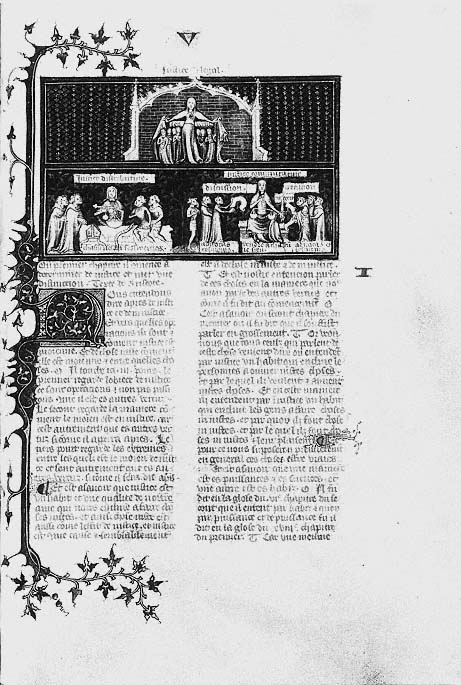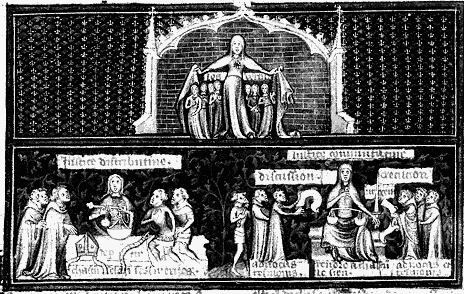The Visual Redefinition in C
In comparison to Figure 24, the illustration for Book V in MS C does not receive the same emphasis. Figure 29 (and Fig. 29a) is the same size as other miniatures in the first half of the book and conforms to the normal structure of the manuscript in its relationship to the text. Placed after the chapter headings, the miniature in C does, however, occupy the top of the page. It shares this elevated frontispiece status only with the illustration of Book II and the dedication page. The rinceau of the upper left border points toward the inscription identifying the main figure and the Roman numeral indicating the number of the book. The rubrics of the first chapter immediately below the miniature set off the sober coloration of the small grisaille figures and the pale brown ink of the inscriptions. In contrast, the jewellike background of the upper register and the wild floral motif in bright blue tones of the lower zone sound an exotic note.
With minor changes, the general iconographic scheme established in Figure 24 continues in Figure 29. In the top zone Justice légale shelters her daughters. Below, the picture field is divided between representations of Justice distributive on the left and Justice commutative on the right. Although the revisions from A to C eliminate the quadrilobes, the concept of two separate scenes remains, but without any demarcation. Consistent with the pattern adopted in C , all three Justices are depicted as nunlike figures.[55] One consequence of this change is that Justice légale is no longer a queen, even though her gold star and large scale indicate her supernatural status. The two Justices below have lost their vitality, as well as the prominence conferred by the bright red robes they wore in Figure 24. Indeed, the two lower scenes of Figure 29 lack the distinctive psychological and physical tensions among the witnesses and parties at law. The frontality adopted for all three types of Justice here conveys an undifferentiated majesty. The sameness of the type brings about a static, lifeless quality reflected in the boneless, unarticulated forms of the tiny figures.
Certain editorial revisions in Figure 29 sharpen or blur essential relationships present in Figure 24. For example, the inscriptions no longer unfurl dramatically but are placed neatly in a uniform, rectangular format above the heads of the three main figures, and the caption identifying Justice légale is placed above the frame. Her daughters have lost their individual attributes and labels and instead share a collective identity. The inscription "les vertuz," inserted on the underside of Justice légale's cloak, suggests that this identification was an afterthought. The addition of a seventh daughter permits a division into a familiar sequence suggesting four cardinal and three theological virtues. Although inappropriate in the Aristotelian context, such a series is more uniform than the six daughters in Figure 24, of whom two are nameless. Furthermore, the somewhat ungainly city gateway of Figure 24 gives way to a more elegant stone tabernacle with two small side turrets and a central fleur-de-lis boss. As a whole, the structure suggests a temple or shrine of Justice, a feature of a twelfth-century legal treatise.[56] This reworking of the city gate motif of Figure 24 reinforces the argument in favor of the image's secular orientation. The location of the shrine of Justice in France is conveyed by the motif of the fleur-de-lis common to the central boss and to the pattern of the background.
The crowded lower register contrasts greatly with the compression and isolation of the representation of Justice légale above. Set against a strong branching pattern, twelve figures (five on the left, seven on the right) are crowded into a very small space. The dramatic approach to these scenes in Figure 24 yields in Figure 29 to a more didactic method. Additional inscriptions are necessary as a consequence of the sameness of the sisters' actions. This strategy further overburdens the picture field. In the left scene, Justice distributive no longer disburses gold, precious objects, or offices, as is the case in Figure 24b. Using the conventional symbol of the scale, she literally weighs the claims of a pair of clerics on the left against those of two secular people on the other side. On the table in front of her lie a gold miter and a sword, symbols of the two competing sources of authority. Not surprisingly, the larger pan of her scale comes down on the secular side. The inscription at the bottom, "departir a chascun selon les merites" (distribute to each one according to his merits), reinforces the visual action. This revision of the analogous scene in A makes explicit the more allusive reference there to the struggle between the secular and ecclesiastic courts.
Even lengthier inscriptions crowd the scene featuring Justice commutative. Unlike the compassionate and impartial judge of Figure 24, this one sits in a full-length, frozen, frontal position. She holds a balance in her right hand, a sword in her left. The second attribute alludes to the penalties Justice commutative can impose. The evenly poised pans of her scale indicate her impartiality, as she fulfills her function to "rendre a chascun le sien" (to render each one his due). Below the groups of figures on each side of her are identical inscriptions. "Advocas et tesmoins" (lawyer and witness) designate two of the three men. The last set of inscriptions, "discussion" and "execucion urgens," identifies twin aspects of a court case. The figure on the left of the scene, a court official who holds a baton or rod, affirms the legal nature of the proceedings. A feature of Figure 24b is the

Figure 29
Above : Justice légale and the Virtues; below : Justice distributive, Justice commutative.
Les éthiques d'Aristote, MS C.

Figure 29A
Detail of Fig. 29
judgment of Justice commutative between civil and clerical litigants. In Figure 29, however, such a contest shifts to the opposite scene featuring Justice distributive, while the case presided over by her sister concerns a more general category of legal action.
Depersonalization of the sister judges in MS C reflects their loss of activity. Physical distance and spiritual separation from the parties at law are accentuated by their rigid postures and frontal stares. Perhaps the very liveliness of the female judges of Figure 24 prompted a negative critique by the king, the translator, or both. In any case, their counterparts in Figure 29 revert to a more passive and traditional representational mode.